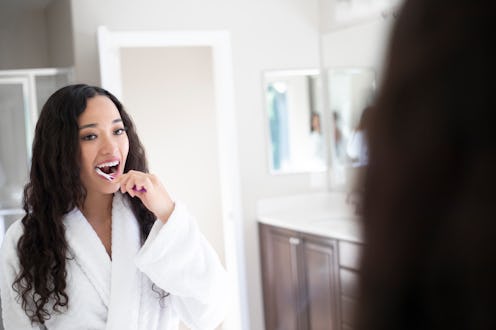Wellness
Here's How Often You Should Change Your Toothbrush
Those bristles can get pretty yucky if not replaced.

Even if your toothbrush looks perfectly fine sitting there in its cup on the side of the sink, it might need to be replaced. Besides looking less fresh after weeks or months of daily use, the bristles actually become less effective at their brushing job over time. Not only that, but an old toothbrush can get to the point where it harbors bad bacteria and mold — making the case for a more frequent trip to the dental care aisles.
How often to change toothbrush rules are pretty straightforward. “Ideally, you should replace your toothbrush every three to six months,” says dentist Dr. Amanda Lewis, DMD. If that sounds like a lot, keep this in mind: “Tooth enamel is the hardest substance in the human body, so when you’re using your toothbrush every day, it does wear out the fibers that they’re made of,” she explains. Once the bristles become splayed and frayed their effectiveness decreases, which could up your risk of cavities, bad breath, and other oral health issues.
Then there’s the bacteria factor. While anything can and will gather bacteria, your toothbrush is a veritable Petri dish. “When a toothbrush is not given time to dry, it can attract particles in the air that begin to harbor and grow a colony of harmful bacteria,” dentist Dr. Mariya Malin, DDS tells Bustle. Not to mention, if your toothbrush is kept right next to a toilet it can also come in contact with bacteria like E. coli. Um, yuck.
How To Make Your Toothbrush Last
While you’ll always want to replace your toothbrush before the six month mark, there are plenty of ways to keep it as fresh as possible in the meantime. Dr. Umang Patel, a dentist based in Chicago, Illinois, recommends thoroughly rinsing the bristles and, if you have an electric toothbrush, detaching the wand and cleaning it thoroughly after each use.
“Saliva and toothpaste can get stuck underneath where the brush connects with the wand and can be a cesspool of germs and bacteria, which can lead to getting sick,” he tells Bustle. “Another good way to keep your brush clean is to keep it out on your counter in a toothbrush holder so it can air out during the day.”
If you store your toothbrush in a wet container or throw it in a drawer, bacteria will be more likely to grow, so leave it out in the air to let it properly dry between each use. For an extra dose of protection, Patel recommends pouring a little mouthwash over your brush after each use to help clear any remaining germs or bacteria. You can do this before brushing if you want, too.
The overall consensus? Dental hygiene calls for proper toothbrush hygiene, too.
Studies referenced:
Gallob, J. (2015). Randomized controlled trial comparing a powered toothbrush with distinct multi-directional cleaning action to a manual flat trim toothbrush. Am J Dent. 2015 Dec;28(6):351-6. PMID: 26846042.
Frazelle, M. (2012). Toothbrush Contamination: A Review of the Literature. Nursing Research and Practice,vol. 2012,Article ID 420630,6pages.https://doi.org/10.1155/2012/420630
Karibasappa GN. (2011). Assessment of microbial contamination of toothbrush head: an in vitro study. Indian J Dent Res. 22(1):2-5. doi: 10.4103/0970-9290.79965. PMID: 21525668.
Kayombo, C.M. (2017). Self-Reported Halitosis in relation to Oral Hygiene Practices, Oral Health Status, General Health Problems, and Multifactorial Characteristics among Workers in Ilala and Temeke Municipals, Tanzania. Int J Dent. https://www.ncbi.nlm.nih.gov/pmc/articles/PMC5322417/
Richards D. (2012). How clean is your toothbrush? Evid Based Dent. 2012;13(4):111. doi: 10.1038/sj.ebd.6400895. PMID: 23258178.
Tangade, P. S., Shah, A. F., Ravishankar, T. L., Tirth, A., & Pal, S. (2013). Is plaque removal efficacy of toothbrush related to bristle flaring? A 3-month prospective parallel experimental study. Ethiopian journal of health sciences, 23(3), 255–264. https://doi.org/10.4314/ejhs.v23i3.8
Experts:
Dr. Amanda Lewis, DMD, dentist
Dr. Mariya Malin, DDS, dentist
Dr. Umang Patel, dentist